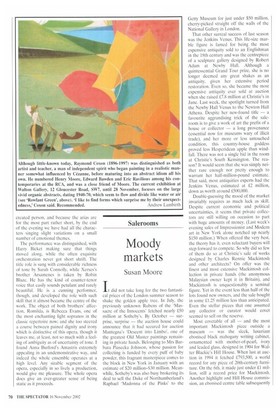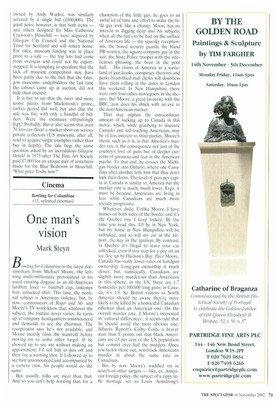Moody markets
Susan Moore
It did not take long for the two fantastical prices of the London summer season to shake the golden apple tree. In July, the previously unknown Rubens of the 'Massacre of the Innocents' fetched nearly £50 million at Sotheby's. By October — surprise, surprise — the auction house could announce that it had secured for auction Mantegna's 'Descent into Limbo', one of the greatest Old Master paintings remaining in private hands. Belonging to Mrs Barbara Piasecka Johnson, whose passion for collecting is funded by every puff of baby powder, this fragrant masterpiece comes to the block in New York in January with an estimate of $20 million-530 million. Meanwhile, Sotheby's was also busy brokering its deal to sell the Duke of Northumberland's Raphael 'Madonna of the Pinks' to the
Getty Museum for just under $50 million, cherry-picked straight off the walls of the National Gallery in London.
That other surreal success of last season was the Jenkins Venus. This life-size marble figure is famed for being the most expensive antiquity sold to an Englishman in the 18th century and was the centrepiece of a sculpture gallery designed by Robert Adam at Newby Hall. Although a quintessential Grand Tour prize, she is no longer deemed any great shakes as an antiquity, given her extensive period restoration. Even so, she became the most expensive antiquity ever sold at auction when she raised £7.8 million at Christie's in June. Last week, the spotlight turned from the Newby Hail Venus to the Newton Hall Athena. Despite her new-found title — a favourite aggrandising trick of the saleroom is to give a work of art the prefix of a house or collector — a long provenance (essential now for museums wary of illicit trade), and her more or less untouched condition, this country-house goddess proved less Hesperidean apple than windfall. There was not a single bid in the room at Christie's South Kensington. The reason? It would seem that she was simply neither rare enough nor pretty enough to warrant her half-million-pound estimate. That said, most antiquities experts had the Jenkins Venus, estimated at £2 million, down as worth around £500,000.
Double-guessing the mood of the market invariably requires as much luck as skill. Despite current economic and political uncertainties, it seems that private collectors are still willing on occasion to part with huge amounts of money. (Last week's evening sales of Impressionist and Modern art in New York alone notched up nearly $150 million.) When offered the very best, the theory has it, even reluctant buyers will step forward to compete. So why did so few of them do so at Christie's sale of works designed by Charles Rennie Mackintosh and other architects? On offer was the finest and most extensive Mackintosh collection in private hands (the anonymous Malaysian owner kept it in Britain). and Mackintosh is unquestionably a seminal figure. Yet in the event less than half of the lots found new owners, and the sale bought in some £1,25 million less than anticipated. Even the stellar pieces that one assumed any collector or curator would covet seemed to sell on the reserve.
Most covetable of all — and the most important Mackintosh piece outside a museum — was the sleek, luxuriant ebonised black mahogany writing cabinet, ornamented with mother-of-pearl, ivory and leaded glass, designed in 1904 for Walter Blackie's Hill House. When last at auction in 1994 it fetched £793,500, a world record for any piece of 20th-century furniture. On the 6th, it made just under £1 million, still a record price for Mackintosh. Another highlight and Hill House commission, an ebonised centre table subsequently owned by Andy Warhol, was similarly secured by a single bid (£300,000). The good news, however, is that both items — and others designed for Miss Catherine Cranston's Hous'hill — were acquired by Glasgow City Council and the National Trust for Scotland and will return home. For once, museum funding was in place prior to a sale — the top lots had come from overseas and could not be exportstopped. It is tempting to speculate that the lack of museum competition may have been partly due to the fact that the Glasgow museums, underbidders the last time the cabinet came up at auction, did not hide their interest.
It is fair to say that the rarer and more iconic pieces from Mackintosh's prime, earlier period did well, but also that the sale was flat, with only a handful of bidders. Were the estimates off-puttingly high? Probably. But it also seems that even 70 lots can flood a market short on serious private collectors (US museums, after all, tend to acquire single examples rather than buy in depth). The sale begs the same question asked by an incredulous Glasgow Herald in 1973 after The Fine Art Society paid £7,000 for an unique pair of armchairs made for the Blue Bedroom at Hous'hill. 'What price Toshy now?'



























































































 Previous page
Previous page